Synthesis, Crystal Structure, and Some Transformations of 9,12-Dichloro-ortho-Carborane
Abstract
:1. Introduction
2. Results and Discussion
3. Materials and Methods
3.1. General Methods
3.2. Synthetic Procedure of ortho-Carborane Chlorination and Characterization of Mono-, Di- and Trisubstituted Chloro Derivatives of ortho-Carborane
3.3. Synthesis of 9-Chloro-ortho-Carborane (1)
3.4. Synthesis of Trimethylammonium Salt of 5,6-Dichloro-nido–Carborane (4)
3.5. Synthesis of Potassium Salt of 9,9′,12,12′-Tetrachloro Cobalt bis(Dicarbollide) (5)
3.6. Synthesis of Cesium Salt of 8,8′,9,9′,12,12′-Hexachloro Cobalt bis(Dicarbollide) (6)
3.7. Single Crystal X-ray Diffraction Study
Supplementary Materials
Author Contributions
Funding
Data Availability Statement
Acknowledgments
Conflicts of Interest
References
- Schroeder, H.; Heying, T.L.; Reiner, J.R. A new series of organoboranes. II. The chlorination of 1,2-dicarbaclovododecaborane(12). Inorg. Chem. 1963, 2, 1092–1096. [Google Scholar] [CrossRef]
- Zakharkin, L.I.; Okhlobystin, O.Y.; Semin, G.K.; Babushkina, T.A. Exchange of hydrogen by chlorine in the system barene-CCl4 or CHCl3 under the influence of aluminum chloride. Russ. Chem. Bull. 1965, 14, 1886. [Google Scholar] [CrossRef]
- Zakharkin, L.I.; Stanko, V.I.; Klimova, A.I. Radical and electrophilic halogenation of barene and phenylbarene. Russ. Chem. Bull. 1966, 15, 1882–1888. [Google Scholar] [CrossRef]
- Schroeder, H.; Reiner, J.R.; Alexander, R.P.; Heying, T.L. Perchlorocarborane and perchloroneocarborane. Inorg. Chem. 1964, 3, 1464–1465. [Google Scholar] [CrossRef]
- Zakharkin, L.I.; Ogorodnikova, N.A. Preparation and study of decachloro-o-carborane (o-B10Cl10C2H2). J. Organomet. Chem. 1968, 12, 13–22. [Google Scholar] [CrossRef]
- Potenza, J.A.; Lipscomb, W.N. Molecular structure of carboranes. A 1,2-dicarbaclovododecaborane derivative, B10Cl8H2C2H2. Inorg. Chem. 1964, 3, 1673–1679. [Google Scholar] [CrossRef]
- Pawley, G.S. Further refinements of some rigid boron compounds. Acta Crystallogr. Sect. C 1966, 20, 631–638. [Google Scholar] [CrossRef]
- Yanovskii, A.I.; Struchkov, Y.T.; Vinogradova, L.E.; Leites, L.A. X-Ray crystallographic investigation of the adduct of decachloro-o-carborane with dimethyl sulfoxide. Russ. Chem. Bull. 1982, 31, 1988–1991. [Google Scholar] [CrossRef]
- L’Esperance, R.P.; Li, Z.; van Engen, D.; Jones, M. New syntheses of 1,2-ethano-o-carborane and the structure of 9-chloro-1,2-ethano-o-carborane. Inorg. Chem. 1989, 28, 1823–1826. [Google Scholar] [CrossRef]
- Rusakova, G.M.; Gusev, A.I.; Parfenov, B.P.; Pechurina, S.Y.; Chesnokova, I.V.; Voloshina, N.S. X-ray crystallographic investigation of 8,9,10,12-tetrachloro-1,2-di(hydroxymethyl)-o-carborane. J. Struct. Chem. 1991, 31, 821–824. [Google Scholar] [CrossRef]
- Andrews, J.S.; Zayas, J.; Jones, M. 9-Iodo-o-carborane. Inorg. Chem. 1985, 24, 3715–3716. [Google Scholar] [CrossRef]
- Li, J.; Logan, C.F.; Jones, M. Simple syntheses and alkylation reactions of 3-iodo-o-carborane and 9,12-diiodo-o-carborane. Inorg. Chem. 1991, 30, 4866–4868. [Google Scholar] [CrossRef]
- Zheng, Z.; Jiang, W.; Zinn, A.A.; Knobler, C.B.; Hawthorne, M.F. Facile electrophilic iodination of icosahedral carboranes. Synthesis of carborane derivatives with boron-carbon bonds via the palladium-catalyzed reaction of diiodocarboranes with Grignard reagents. Inorg. Chem. 1995, 34, 2095–2100. [Google Scholar] [CrossRef]
- Jiang, W.; Knobler, C.B.; Curtis, C.E.; Mortimer, M.D.; Hawthorne, M.F. Iodination reactions of icosahedral para-carborane and the synthesis of carborane derivatives with boron-carbon bonds. Inorg. Chem. 1995, 34, 3491–3498. [Google Scholar] [CrossRef]
- Barberà, G.; Teixidor, F.; Viñas, C.; Sillanpää, R.; Kivekäs, R. Sequential nucleophilic-electrophilic reactions selectively produce isomerically pure nona-B-substituted o-carborane derivatives. Eur. J. Inorg. Chem. 2003, 2003, 1511–1513. [Google Scholar] [CrossRef]
- Yamazaki, H.; Ohta, K.; Endo, Y. Regioselective synthesis of triiodo-o-carboranes and tetraiodo-o-carborane. Tetrahedron Lett. 2005, 46, 3119–3122. [Google Scholar] [CrossRef]
- Vaca, A.; Teixidor, F.; Kivekäs, R.; Sillanpää, R.; Viñas, C. A solvent-free regioselective iodination route of ortho-carboranes. Dalton Trans. 2006, 41, 4884–4885. [Google Scholar] [CrossRef]
- Teixidor, F.; Barberà, G.; Viñas, C.; Sillanpää, R.; Kivekäs, R. Synthesis of boron-iodinated o-carborane derivatives. Water stability of the periodinated monoprotic salt. Inorg. Chem. 2006, 45, 3496–3498. [Google Scholar] [CrossRef]
- Barberà, G.; Vaca, A.; Teixidor, F.; Sillanpää, R.; Kivekäs, R.; Viñas, C. Designed synthesis of new ortho-carborane derivatives: From mono- to polysubstituted frameworks. Inorg. Chem. 2008, 47, 7309–7316. [Google Scholar] [CrossRef]
- Rudakov, D.A.; Kurman, P.V.; Potkin, V.I. Synthesis and deborination of polyhalo-substituted ortho-carboranes. Russ. J. Gen. Chem. 2011, 81, 1137–1142. [Google Scholar] [CrossRef]
- Safronov, A.V.; Sevryugina, Y.V.; Jalisatgi, S.S.; Kennedy, R.D.; Barnes, C.L.; Hawthorne, M.F. Unfairly forgotten member of the iodocarborane family: Synthesis and structural characterization of 8-iodo-1,2-dicarba-closo-dodecaborane, its precursors, and derivatives. Inorg. Chem. 2012, 51, 2629–2637. [Google Scholar] [CrossRef] [PubMed]
- Lyu, H.; Quan, Y.; Xie, Z. Transition metal catalyzed, regioselective B(4)-halogenation and B(4,5)-diiodination of cage B-H bonds in o-carboranes. Chem. Eur. J. 2017, 23, 14866–14871. [Google Scholar] [CrossRef] [PubMed]
- Körbe, S.; Schreiber, P.J.; Michl, J. Chemistry of the carba-closo-dodecaborate(−) anion, CB11H12−. Chem. Rev. 2006, 106, 5208–5249. [Google Scholar] [CrossRef] [PubMed]
- Douvris, C.; Michl, J. Update 1 of: Chemistry of the carba-closo-dodecaborate(−) anion, CB11H12−. Chem. Rev. 2013, 113, R179–R233. [Google Scholar] [CrossRef]
- Kanazawa, J.; Kitazawa, Y.; Uchiyama, M. Recent progress in the synthesis of the monocarba-closo-dodecaborate(−) anions. Chem. Eur. J. 2019, 39, 9123–9132. [Google Scholar] [CrossRef]
- Sivaev, I.B.; Bregadze, V.I.; Sjöberg, S. Chemistry of closo-dodecaborate anion [B12H12]2−: A review. Collect. Czechoslov. Chem. Commun. 2002, 67, 679–727. [Google Scholar] [CrossRef]
- Zhao, X.; Yang, Z.; Chen, H.; Wang, Z.; Zhou, X.; Zhang, H. Progress in three-dimensional aromatic-like closo-dodecaborate. Coord. Chem. Rev. 2021, 444, 214042. [Google Scholar] [CrossRef]
- Knapp, C. Weakly coordinating anions: Halogenated borates and dodecaborates. In Comprehensive Inorganic Chemistry II; Elsevier: Amsterdam, The Netherlands, 2013; Volume 1, pp. 651–679. [Google Scholar] [CrossRef]
- Avdeeva, V.V.; Malinina, E.A.; Sivaev, I.B.; Bregadze, V.I.; Kuznetsov, N.T. Silver and copper complexes with closo-polyhedral borane, carborane and metallacarborane anions: Synthesis and X-ray structure. Crystals 2016, 6, 60. [Google Scholar] [CrossRef]
- Sivaev, I.B.; Bregadze, V.I. Borane, carborane and metallacarborane anions for stabilization of transient and highly reactive intermediates. In Handbook of Boron Science with Applications in Organometallics, Catalysis, Materials and Medicine; Hosmane, N.S., Eagling, R., Eds.; World Scientific: London, UK, 2019; Volume 1, pp. 147–203. [Google Scholar] [CrossRef]
- Bolli, C.; Derendorf, J.; Jenne, C.; Scherer, H.; Sindlinger, C.P.; Wegener, B. Synthesis and properties of the weakly coordinating anion [Me3NB12Cl11]−. Chem. Eur. J. 2014, 20, 13783–13792. [Google Scholar] [CrossRef]
- Saleh, M.; Powell, D.R.; Wehmschulte, R.J. Chlorination of 1-carba-closo-dodecaborate and 1-ammonio-closo-dodecaborate anions. Inorg. Chem. 2016, 55, 10617–10627. [Google Scholar] [CrossRef]
- Jenne, C.; Wegener, B. Silver salts of the weakly coordinating anion [Me3NB12Cl11]−. Z. Anorg. Allg. Chem. 2018, 644, 1123–1132. [Google Scholar] [CrossRef]
- Wehmschulte, R.J.; Bayliss, B.; Reed, S.; Wesenberg, C.; Morgante, P.; Peverati, R.; Neal, S.; Chouinard, C.D.; Tolosa, D.; Powell, D.R. Zinc ammonio-dodecaborates: Synthesis, Lewis acid strength, and reactivity. Inorg. Chem. 2022, 61, 7032–7042. [Google Scholar] [CrossRef] [PubMed]
- Zakharkin, L.I.; Kalinin, V.N.; Lozovskaya, L.S. Formation of isomeric compounds in the halogenation of bareness and neobarenes. I. Mono- and dehalogenation of barene and neobarene. Russ. Chem. Bull. 1968, 17, 1683–1688. [Google Scholar] [CrossRef]
- Xu, T.-T.; Zhang, C.-Y.; Cao, K.; Wu, J.; Jiang, L.; Li, J.; Li, B.; Yang, J. Palladium-catalyzed selective mono-chlorination of o-carboranes: Changing the concept of FeCl3 from Lewis acid to chlorine source in carboranes. ChemistrySelect 2017, 2, 3396–3399. [Google Scholar] [CrossRef]
- Rudakov, D.A.; Kurman, P.V.; Lugin, V.G.; Laikovskaya, I.V.; Dikusar, E.A. Synthesis of 8,9,12-trichloro-1,2-dicarba-closo-dodecaborane under increased pressure and its consequent deboronation. Proc. Natl. Acad. Sci. Belarus Chem. Ser. 2016, 1, 46–51. [Google Scholar]
- Rudakov, D.A.; Kurman, P.V.; Dikusar, E.A.; Zvereva, T.D.; Potkin, V.I. Synthesis of chlorinated ortho-carboranes. In Proceedings of the XXX Scientific and Technical Conference “Chemical Reagents and Processes of Low-Tonnage Chemistry”, Ufa, Russia, 14–16 November 2016; pp. 96–97. [Google Scholar]
- Guo, W.; Guo, C.; Ma, Y.-N.; Chen, X. Practical synthesis of B(9)-halogenated carboranes with N-haloamides in hexafluoroisopropanol. Inorg. Chem. 2022, 61, 5326–5334. [Google Scholar] [CrossRef]
- Štíbr, B.; Tok, O.L.; Holub, J. Quantitative assessment of substitution NMR effects in the model series of o-carborane derivatives: α-Shift correlation method. Inorg. Chem. 2017, 56, 8334–8340. [Google Scholar] [CrossRef]
- Puga, A.V.; Teixidor, F.; Sillanpää, R.; Kivekäs, R.; Viñas, C. Iodinated ortho-carboranes as versatile building blocks to design intermolecular interactions in crystal lattices. Chem. Eur. J. 2009, 15, 9764–9772. [Google Scholar] [CrossRef]
- Suponitsky, K.Y.; Anisimov, A.A.; Anufriev, S.A.; Sivaev, I.B.; Bregadze, V.I. 1,12-Diiodo-ortho-carborane: A classic textbook example of the dihalogen bond. Crystals 2021, 11, 396. [Google Scholar] [CrossRef]
- Fanfrlík, J.; Holub, J.; Růžičková, Z.; Řezáč, J.; Lane, P.D.; Wann, D.A.; Hnyk, D.; Růžička, A.; Hobza, P. Competition between halogen, hydrogen and dihydrogen bonding in brominated carboranes. ChemPlusChem 2016, 17, 3373–3376. [Google Scholar] [CrossRef]
- Zhidkova, O.B.; Druzina, A.A.; Anufriev, S.A.; Suponitsky, K.Y.; Sivaev, I.B.; Bregadze, V.I. Synthesis and crystal structure of 9,12-dibromo-ortho-carborane. Molbank 2022, 2022, M1347. [Google Scholar] [CrossRef]
- Cavallo, G.; Metrangolo, P.; Milani, R.; Pilati, T.; Priimagi, A.; Resnati, G.; Terraneo, G. The halogen bond. Chem. Rev. 2016, 116, 2478–2601. [Google Scholar] [CrossRef]
- de las Nieves Piña, M.; Bauza, A.; Frontera, A. Halogen···halogen interactions in decahalo-closo-carboranes: CSD analysis and theoretical study. Phys. Chem. Chem. Phys. 2020, 22, 6122–6130. [Google Scholar] [CrossRef] [PubMed]
- Fanfrlik, J.; Hnyk, D. Dihalogen and pnictogen bonding in crystalline icosahedral phosphaboranes. Crystals 2018, 8, 390. [Google Scholar] [CrossRef]
- Zefirov, Y.V.; Zorky, P.M. New applications of van der Waals radii in chemistry. Russ. Chem. Rev. 1995, 64, 415–428. [Google Scholar] [CrossRef]
- Romanovskiy, V.N.; Smirnov, I.V.; Todd, T.A.; Herbst, R.S.; Law, J.D.; Brewer, K.N. The universal solvent extraction (UNEX) process. I. Development of the UNEX process solvent for the separation of cesium, strontium, and the actinides from acidic radioactive waste. Solvent Extr. Ion Exch. 2001, 19, 1–21. [Google Scholar] [CrossRef]
- Logunov, M.V.; Voroshilov, Y.A.; Babain, V.A.; Skobtsov, A.S. Experience of mastering, industrial exploitation, and optimization of the integrated extraction–precipitation technology for fractionation of liquid high-activity wastes at Mayak Production Association. Radiochemistry 2020, 62, 700–722. [Google Scholar] [CrossRef]
- Mátel, L.; Macášek, F.; Rajec, P.; Heřmánek, S.; Plešek, J. B-Halogen derivatives of the bis(1,2-dicarbollyl)cobalt(III) anion. Polyhedron 1982, 1, 511–519. [Google Scholar] [CrossRef]
- Buades, A.B.; Viñas, C.; Fontrodona, X.; Teixidor, F. 1.3 V Inorganic sequential redox chain with an all-anionic couple 1−/2− in a single framework. Inorg. Chem. 2021, 60, 16168–16177. [Google Scholar] [CrossRef] [PubMed]
- Kazheva, O.N.; Aleksandrov, G.G.; Kravchenko, A.V.; Starodub, V.A.; Zhigareva, G.G.; Sivaev, I.B.; Bregadze, V.I.; Buravov, L.I.; Titov, L.V.; D’yachenko, O.A. Synthesis, structures, and conductivities of salts (BEDT-TTF)[9,9′(12′)-I2-3,3′-Co(1,2-C2B9H10)2] and (TTF)[9,9′,12,12′-I4-3,3′-Co(1,2-C2B9H9)2]. Russ. Chem. Bull. 2010, 59, 1137–1144. [Google Scholar] [CrossRef]
- Hurlburt, P.K.; Miller, R.L.; Abney, K.D.; Foreman, T.M.; Butcher, R.J.; Kinkead, S.A. New synthetic routes to B-halogenated derivatives of cobalt dicarbollide. Inorg. Chem. 1995, 34, 5215–5219. [Google Scholar] [CrossRef]
- Sivaev, I.B.; Kosenko, I.D. Rotational conformation of 8,8′-dihalogenated derivatives of cobalt bis(dicarbollide) in solution. Russ. Chem. Bull. 2021, 70, 753–756. [Google Scholar] [CrossRef]
- Benz, M.; Klapötke, T.M.; Stierstorfer, J.; Voggenreiter, M. Synthesis and characterization of binary, highly endothermic, and extremely sensitive 2,2′-azobis(5-azidotetrazole). J. Am. Chem. Soc. 2022, 144, 1643–1647. [Google Scholar] [CrossRef] [PubMed]
- Isotope Distribution Calculator and Mass Spec Plotter. Available online: https://www.sisweb.com/mstools/isotope.htm (accessed on 28 July 2022).
- APEX2 and SAINT; Bruker AXS: Madison, WI, USA, 2014.
- Sheldrick, G.M. Crystal structure refinement with SHELXL. Acta Crystallogr. Sect. C 2015, 71, 3–8. [Google Scholar] [CrossRef]
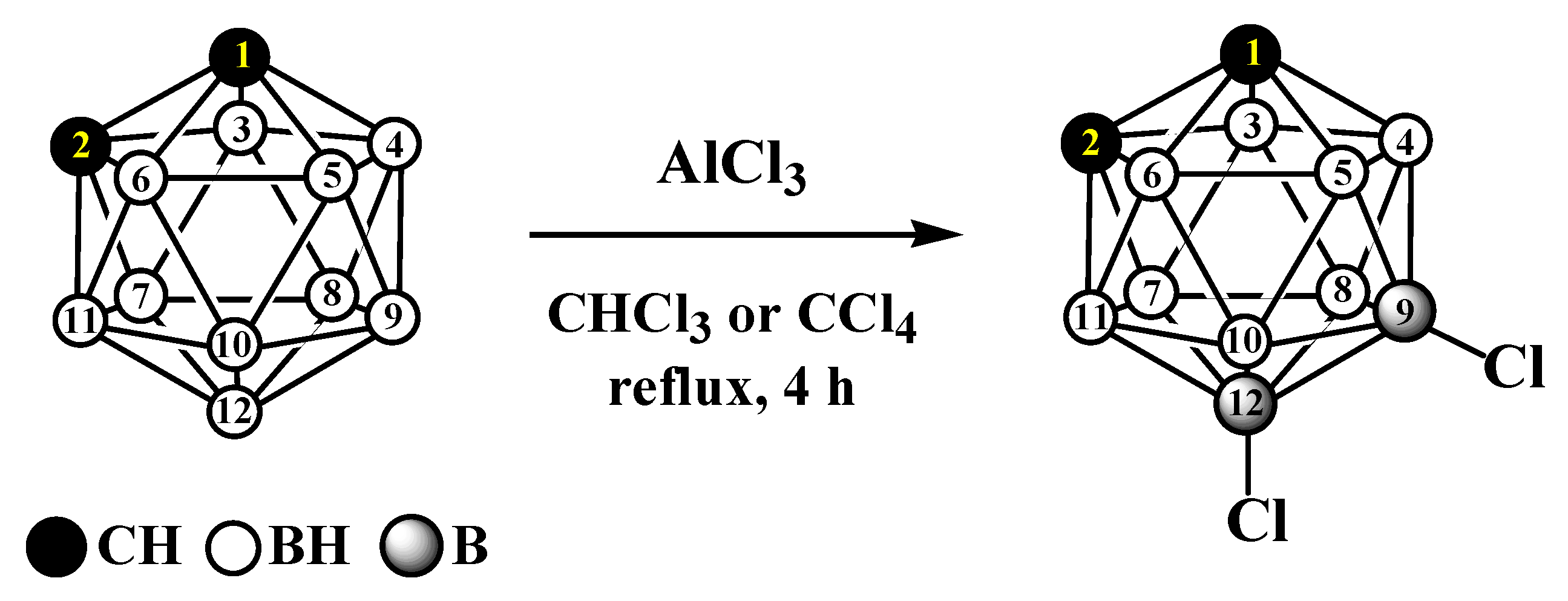
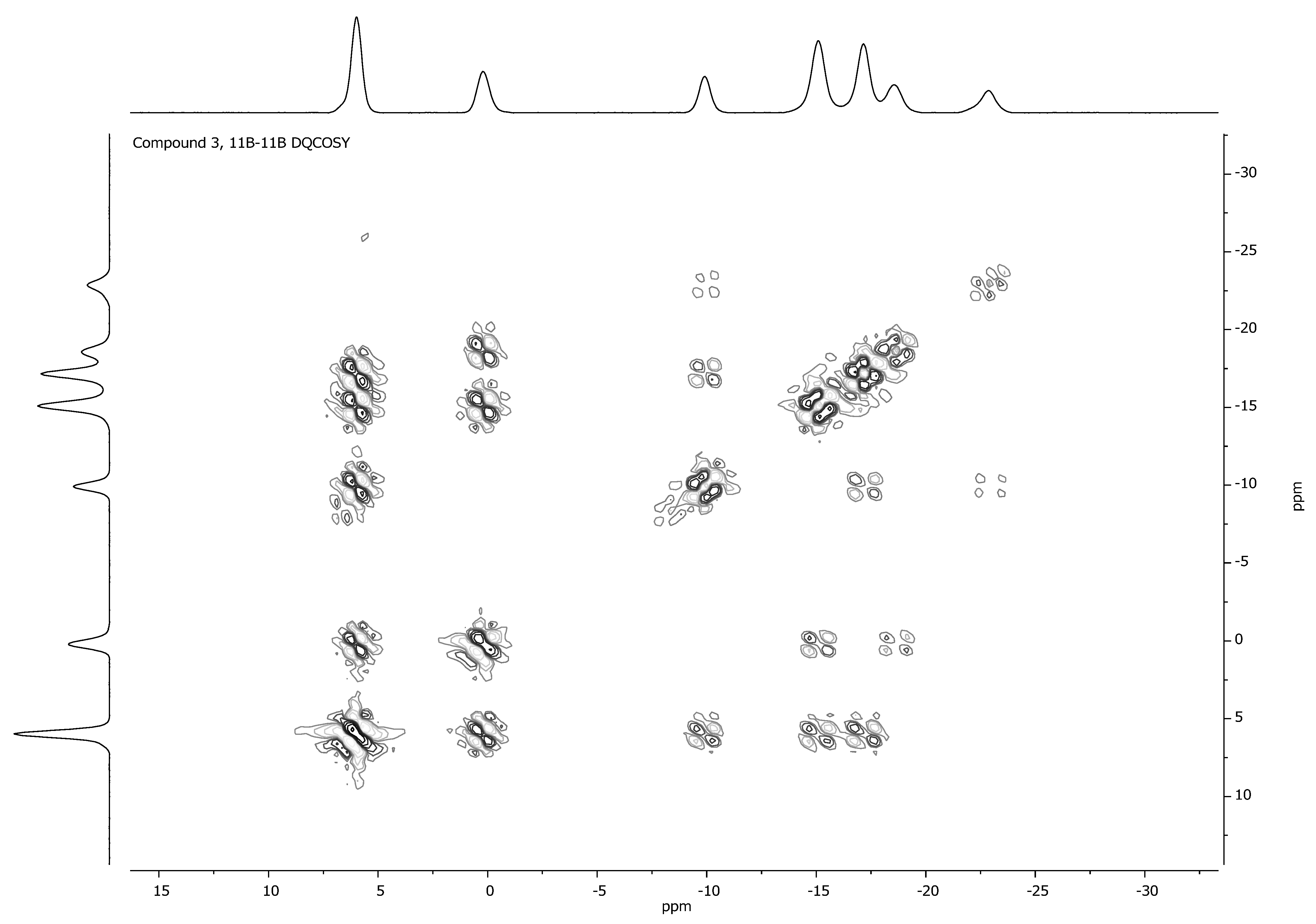
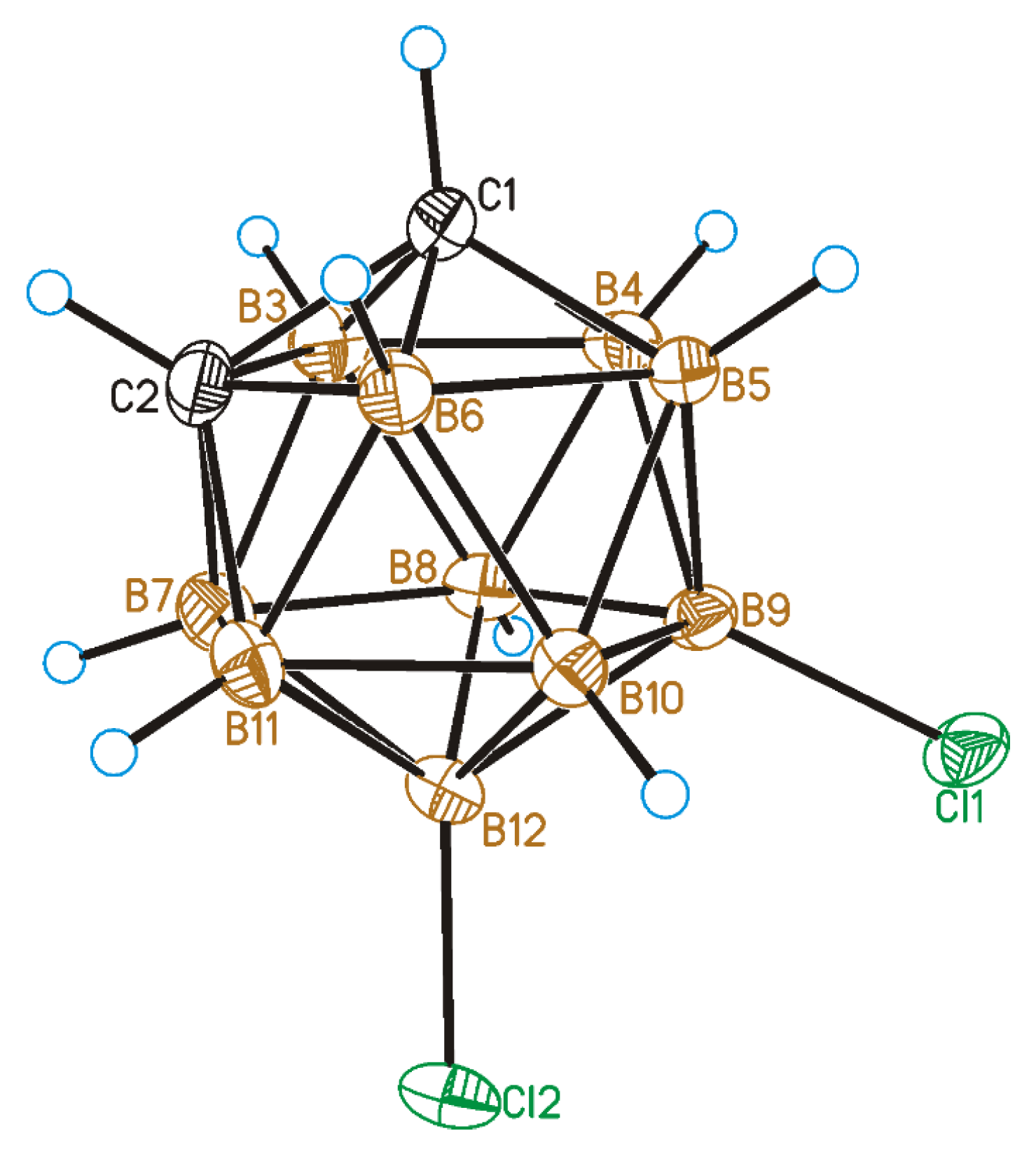
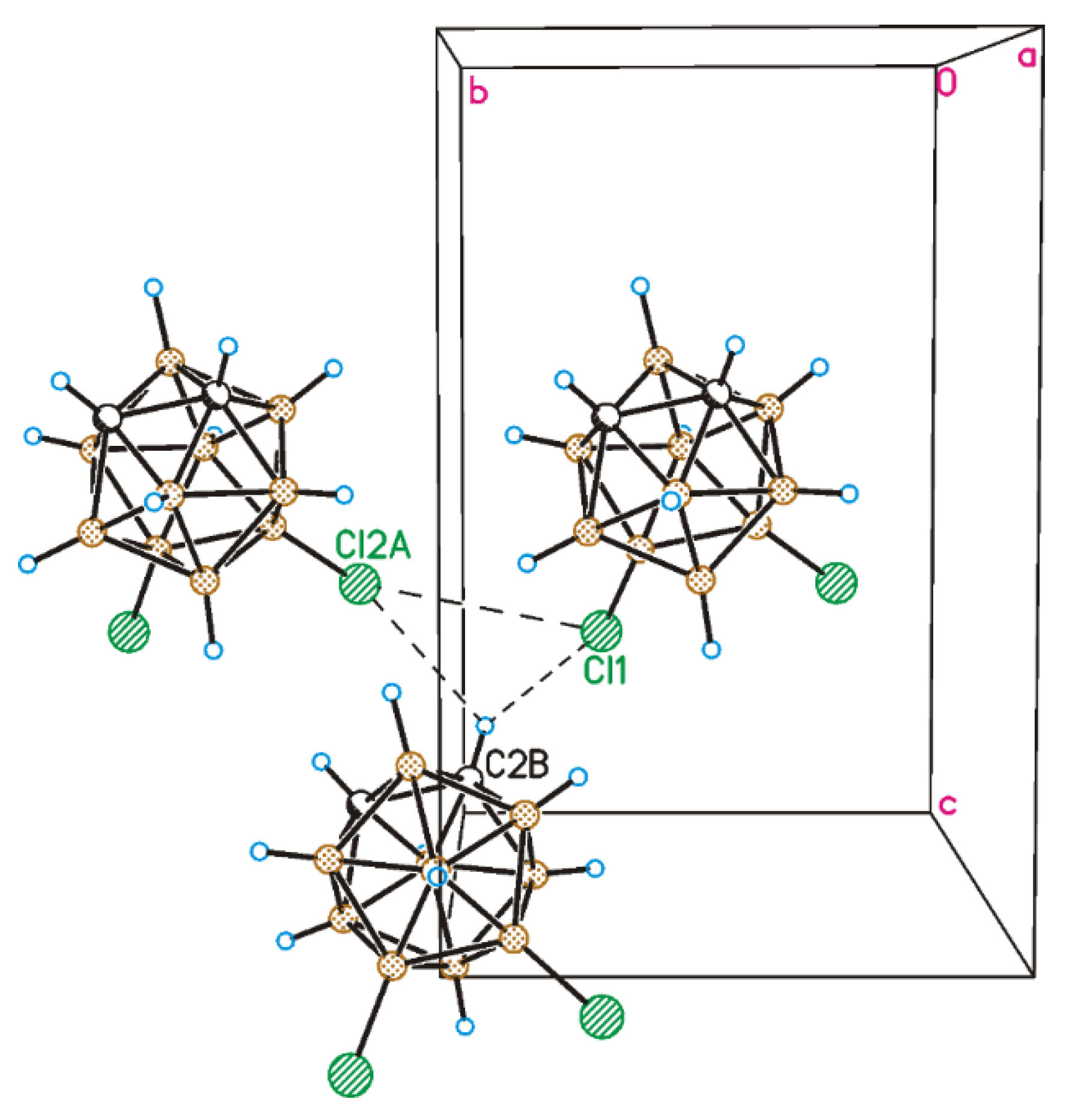


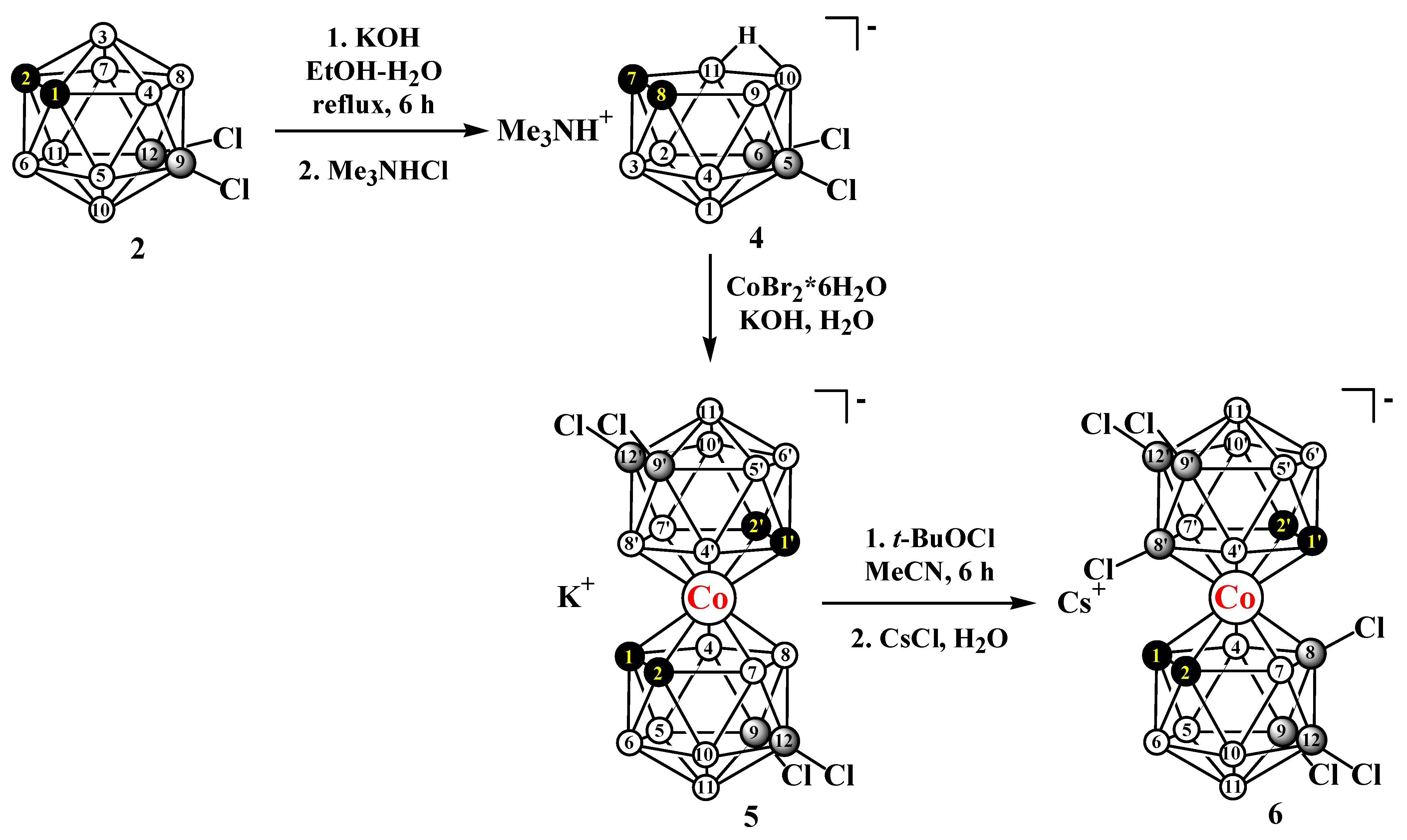
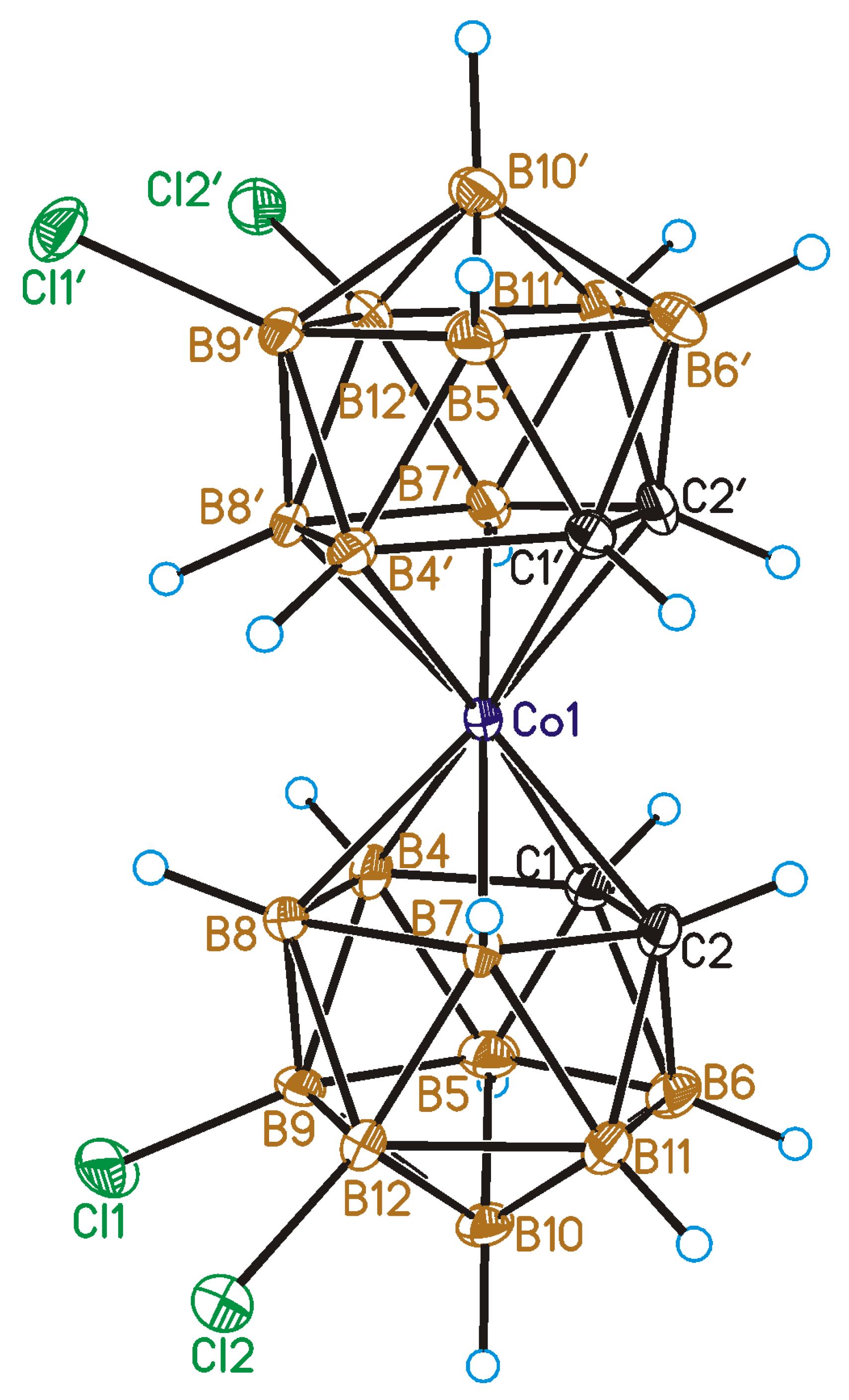
| B-Cl…Cl-B Contact | Cl…Cl | B-Cl…Cl | Cl…Cl-B |
|---|---|---|---|
| B9-Cl9…Cl12-B12 | 3.704(3) | 105.4(3) | 133.8(3) |
| B9-Cl9…Cl8-B8 | 3.870(3) | 139.4(3) | 92.3(3) |
| B12-Cl12…Cl8-B8 | 3.870(3) | 91.0(3) | 149.3(3) |
Publisher’s Note: MDPI stays neutral with regard to jurisdictional claims in published maps and institutional affiliations. |
© 2022 by the authors. Licensee MDPI, Basel, Switzerland. This article is an open access article distributed under the terms and conditions of the Creative Commons Attribution (CC BY) license (https://creativecommons.org/licenses/by/4.0/).
Share and Cite
Anufriev, S.A.; Timofeev, S.V.; Zhidkova, O.B.; Suponitsky, K.Y.; Sivaev, I.B. Synthesis, Crystal Structure, and Some Transformations of 9,12-Dichloro-ortho-Carborane. Crystals 2022, 12, 1251. https://doi.org/10.3390/cryst12091251
Anufriev SA, Timofeev SV, Zhidkova OB, Suponitsky KY, Sivaev IB. Synthesis, Crystal Structure, and Some Transformations of 9,12-Dichloro-ortho-Carborane. Crystals. 2022; 12(9):1251. https://doi.org/10.3390/cryst12091251
Chicago/Turabian StyleAnufriev, Sergey A., Sergey V. Timofeev, Olga B. Zhidkova, Kyrill Yu. Suponitsky, and Igor B. Sivaev. 2022. "Synthesis, Crystal Structure, and Some Transformations of 9,12-Dichloro-ortho-Carborane" Crystals 12, no. 9: 1251. https://doi.org/10.3390/cryst12091251
APA StyleAnufriev, S. A., Timofeev, S. V., Zhidkova, O. B., Suponitsky, K. Y., & Sivaev, I. B. (2022). Synthesis, Crystal Structure, and Some Transformations of 9,12-Dichloro-ortho-Carborane. Crystals, 12(9), 1251. https://doi.org/10.3390/cryst12091251







